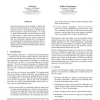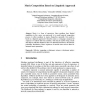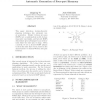2805 search results - page 8 / 561 » Modeling Memory for Melodies |
ISMIR
2003
Springer
14 years 17 days ago
2003
Springer
Query-by-humming systems attempt to address the needs of the non-expert user, for whom the most natural query format – for the purposes of finding a tune, hook or melody of unk...
MICAI
2010
Springer
13 years 5 months ago
2010
Springer
Music is a form of expression. Since machines have limited capabilities in this sense, our main goal is to model musical composition process, to allow machines to express themselve...
WIA
2005
Springer
14 years 26 days ago
2005
Springer
Abstract. Stochastic deterministic finite automata have been introduced and are used in a variety of settings. We use them to model musical styles: a same automaton can be used to...
UAI
2007
13 years 8 months ago
2007
This paper introduces decision-theoretic planning techniques into automatic music generation. Markov decision processes (MDPs) are a mathematical model of planning under uncertain...
ISMIR
2004
Springer
14 years 23 days ago
2004
Springer
A set of principles (based on Gestalt theory) governing how we group notes into meaningful groups has been widely accepted in the literature. Based on these principles, many diver...



